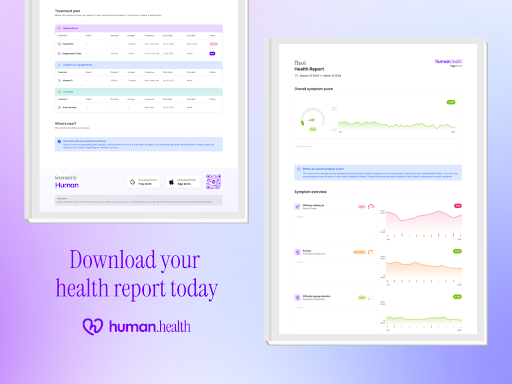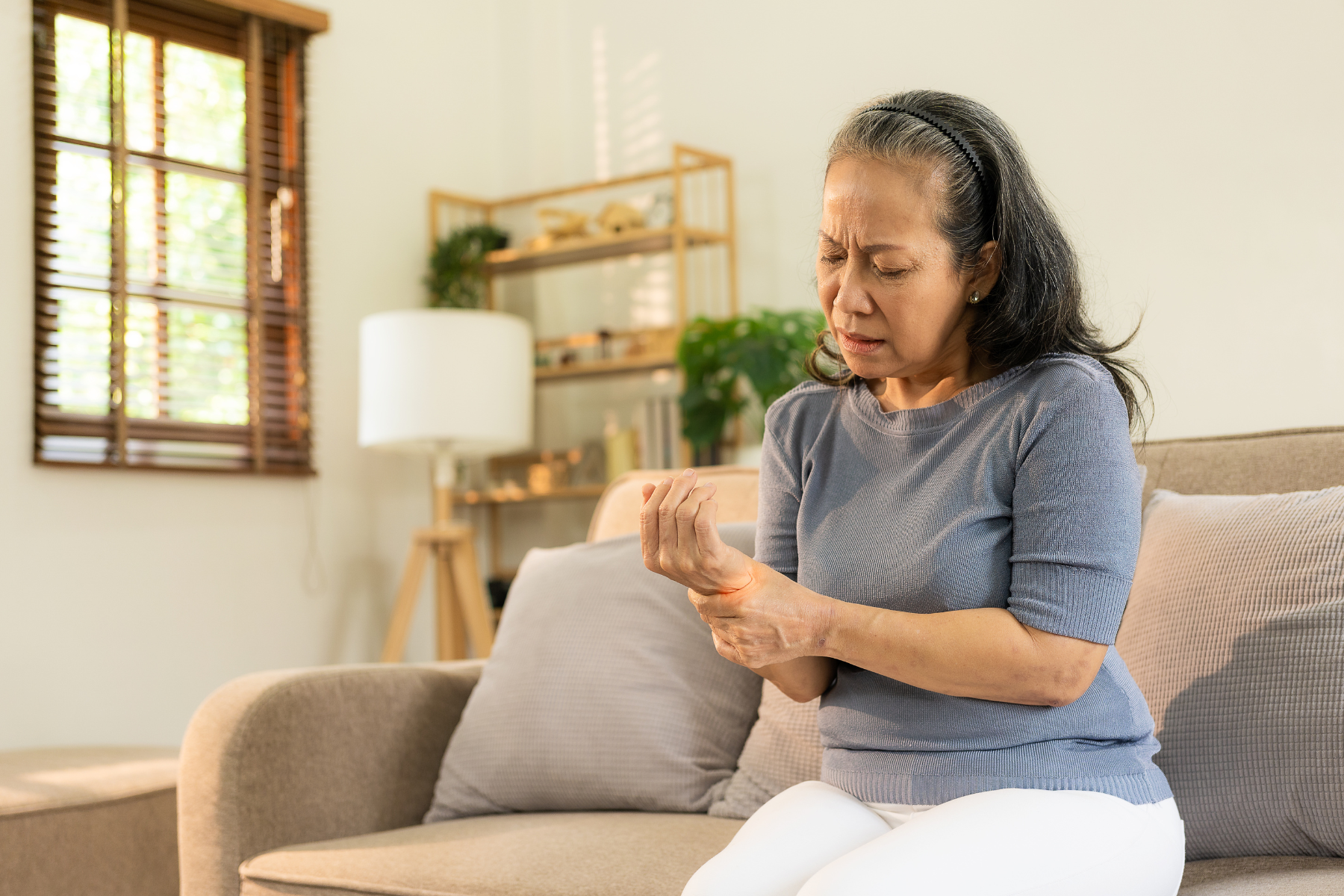Fibromyalgia Breast & Armpit Pain: Causes, Relief & More
November 5, 2025

- Fibromyalgia can cause breast and armpit pain due to widespread nerve sensitivity and muscle tenderness in the chest and upper torso.
- Pain in these areas may feel like aching, burning, or sharp discomfort, often linked to fibro flare-ups or tension in surrounding muscles.
- It’s important to rule out other possible causes such as hormonal changes, infections, or lymph node inflammation.
- Tracking pain patterns and triggers in an app like Human Health can help you and your provider identify trends and manage symptoms safely.
Disclaimer: This article is for informational purposes only. Human Health does not provide medical advice, diagnosis, or treatment. Always consult a qualified healthcare provider about any medical condition or new symptoms.
Breast or underarm pain can be unsettling, especially when you already live with fibromyalgia, a condition known for unpredictable and wide-ranging pain. For many people with fibromyalgia, this discomfort comes and goes without warning, often sparking the question: is this another flare-up, or something new?
Research suggests that up to half of people with fibromyalgia experience breast or chest wall pain at some point. These sensations are usually linked to the way fibromyalgia affects nerves and muscles in the upper torso, rather than to any new or dangerous condition.
In this guide, you’ll learn what fibromyalgia-related breast and armpit pain can feel like, why it happens, when it’s important to see a doctor, and practical ways to ease discomfort. You’ll also see how tracking symptoms with the Human Health app can help you and your provider recognize patterns and make more informed decisions about your care.
Fibromyalgia breast and armpit pain: Is it normal?
Yes. For some people with fibromyalgia, pain can occur around the chest or nearby areas such as the underarms. This happens because fibromyalgia makes the nervous system more sensitive to pain, turning normal sensations into discomfort.
Research suggests fibromyalgia may heighten nerve sensitivity in the brain and spinal cord and contribute to muscle stiffness. This means that even mild pressure or movement in the upper torso can sometimes feel painful. These sensations are generally harmless but uncomfortable, and may flare during stress, fatigue, or hormonal changes.
What does fibromyalgia breast and armpit pain feel like?
It can feel like a deep ache, burning, or sharp tenderness around the chest, upper ribs, or underarms. Some people describe it as soreness that worsens with touch, tight clothing, or sleeping on one side.
When should I be concerned about fibromyalgia-related breast and armpit pain?
While fibromyalgia-related pain is usually benign, it’s important to contact a healthcare provider if you notice new lumps, persistent swelling, redness, or pain that feels different from your usual pattern. These changes can sometimes signal infections, cysts, or other conditions that need prompt evaluation.
Chest or underarm discomfort is a recognized part of fibromyalgia for many people, though it’s not dangerous in itself. Tracking when it appears (and what triggers seem linked) can help you and your healthcare provider spot meaningful patterns and rule out other causes with confidence.
{{inline-cta-1}}
What are the possible causes of fibromyalgia breast & armpit pain?
Fibromyalgia can make muscles, joints, and nerves around the chest and upper torso more sensitive to pain. This discomfort often flares during a fibro episode, when stress, hormonal shifts, or other internal factors make nerves more reactive.
{{pro-tip-1}}
Muscle tension and trigger points
Fibromyalgia often overlaps with myofascial pain, where small muscle knots (trigger points) can develop in the chest or upper arm regions. These knots can radiate pain to nearby regions, making your breasts or armpits feel sore even without an injury.
See how muscle spasms may relate to fibromyalgia pain.
Nerve sensitivity and overactive pain signals
People with fibromyalgia experience amplified pain signaling in the central nervous system. This means nerves in the chest and underarms may send stronger pain messages to the brain, even from light touch or pressure.
Hormonal fluctuations
Hormonal shifts in estrogen and progesterone, such as during premenstrual or menopausal phases, can intensify fibromyalgia symptoms, potentially making breast tissue more sensitive. For those with fibromyalgia, this natural sensitivity may feel more intense because of already heightened pain processing.
While these factors often overlap, they don’t affect everyone in the same way. For some people, pain may come from muscle tension or posture; for others, it might flare with stress or hormonal changes. Tracking when and how your pain appears can help you and your healthcare provider recognize your unique triggers and patterns over time.

Other possible causes of breast & armpit pain
Not all breast or armpit pain is linked to fibromyalgia. Sometimes, other conditions or factors can be responsible, even if you have fibromyalgia. Identifying these possibilities with your healthcare provider can help ensure you’re addressing the right cause.
Lymph node swelling
Lymph nodes under the arms may become swollen or tender from infection, inflammation, or other causes. Though these changes are often temporary, persistent swelling should always be evaluated by a healthcare provider.
Mastitis or infection
Breast infections such as mastitis can cause localized pain, redness, and swelling. They are more common in individuals who are breastfeeding, but may also occur in non-breastfeeding persons. Medical treatment is typically needed.
Muscle strain or poor posture
Muscle tension in the chest or nearby areas can sometimes mimic breast discomfort. Overuse, stress, or prolonged poor posture (such as hunching over a desk) may make these sensations worse. In some cases, pain may radiate toward the shoulder or underarm due to shared muscle and nerve pathways. Some people with fibromyalgia also notice numbness when nerves become irritated.
While these issues are not specific to fibromyalgia, they can overlap or occur at the same time. Because pain in this area can have many explanations, it’s best to check with a healthcare provider to rule out other causes.
Pain relief advice
There’s no single fix for fibromyalgia-related breast or armpit pain, but gentle self-care steps may ease discomfort and prevent fibromyalgia flare-ups from worsening.
#1: Apply warm compresses
Warmth helps relax tight muscles and boost circulation, which can ease tenderness in the chest or underarm. Try a warm compress (or heating pad set to a safe level) for about 10-15 minutes several times a day, just be careful not to apply heat directly onto bare skin.
#2: Gentle stretching and posture breaks
Tension in the chest, shoulders, or upper back muscles can amplify pain sensations. Gentle movements, like light stretching, slow arm circles, or periodic posture resets, can help keep those muscles looser and reduce stiffness over time.
#3: Stress-reduction techniques
Because stress is a known fibromyalgia trigger, strategies like deep breathing, meditation, or short walks may help soothe your nervous system and lessen the severity of pain flare-ups.
These gentle, non-medical approaches won’t remove fibromyalgia pain entirely, but they may help you feel more comfortable and reduce day-to-day tension. Tracking which strategies seem most effective in the Human Health app can help you and your provider see what supports your pain management best.

How to manage fibromyalgia-related breast & armpit pain
Because fibromyalgia affects everyone differently, management is about discovering what works best for you. It often involves small, consistent habits that support your muscles, reduce stress, and help your provider track what’s changing over time.
Prioritize restorative sleep
Poor sleep can heighten pain sensitivity, especially in conditions like fibromyalgia, making symptoms worse. Aim for a regular bedtime routine, a cool, dark room, and gentle stretching before bed. Tracking your sleep quality in the Human Health app can help reveal whether poor rest coincides with flare-ups.
Maintain gentle daily movement
Low-impact exercise, such as walking, swimming, or gentle yoga, may help keep muscles flexible, reduce pain, and support mood in fibromyalgia. Move within your comfort zone and pace yourself, increasing activity slowly over time.
Support muscle recovery
Techniques like massage, warm baths, or self-myofascial release (e.g., foam roller use) may help ease tension in the chest, shoulders, and arms, contributing to symptom relief. These methods are often used alongside professional physical therapy for added relief.
Manage triggers proactively
Keep track of potential flare triggers, such as stress, hormonal changes, weather shifts, or poor posture. Logging these details helps you recognize patterns so you can prepare or adjust ahead of time.
Curious about more relief options? See fibromyalgia natural remedies that may help.
Communicate regularly with your provider
Share your symptom patterns and pain logs with your healthcare provider. This makes conversations more specific and ensures fibromyalgia treatment adjustments are based on real data from your daily life.
{{pro-tip-2}}
When seeing a doctor is recommended
While fibromyalgia-related pain is typically not dangerous, new or unusual breast or armpit pain should always be checked by a healthcare provider to rule out other causes.
Schedule a visit if you notice any of the following:
- New or worsening lumps, swelling, or skin changes in the breast or armpit
- Redness, warmth, or discharge from the nipple area
- Pain that affects only one side or doesn’t improve with self-care
- Persistent fatigue, unexplained weight loss, or fever accompanying the pain
Your provider may perform a physical exam, imaging tests, or lab work to ensure there’s no infection, cyst, or other underlying condition.
Track your fibromyalgia symptoms with the Human Health app
Living with fibromyalgia means managing daily changes in pain, fatigue, and stress. Understanding these shifts is key to feeling more in control. And that starts with consistent tracking.
With the Human Health app, you can:
- Log breast and armpit pain episodes, noting severity, triggers, and relief methods.
- Track related factors like sleep quality, stress levels, and hormonal cycles.
- Generate a PDF summary to share with your healthcare provider for more informed conversations.
- Manage multiple profiles if you or a loved one track different conditions.
Over time, these small logs can reveal big insights, helping you and your provider tailor your care plan and reduce the frustration of uncertainty. Each entry builds a clearer picture of what affects your body and when, so you can make informed choices and feel more confident in managing your fibromyalgia.
{{inline-cta-2}}
Disclaimer: Human Health is a health tracking platform and does not provide medical advice, diagnosis, or treatment. The information in this article is for educational purposes only and should never replace professional medical care. Always consult a qualified healthcare provider regarding any questions about your condition or treatment plan.
References
- National Library of Medicine: Can mastalgia be another somatic symptom in fibromyalgia syndrome?
- National Library of Medicine: Fibromyalgia: Pathogenesis, Mechanisms, Diagnosis and Treatment Options Update
- ResearchGate: Is there an association between mastalgia and fibromyalgia? Comparing prevalence and symptom severity
- National Library of Medicine: Fibromyalgia
- Oregon Health & Science University: The fibromyalgia and myofascial pain syndromes: A preliminary study of tender points and trigger points in persons with fibromyalgia, myofascial pain syndrome and no disease
- Frontiers: Potential Mechanisms Underlying Centralized Pain and Emerging Therapeutic Interventions
- MDPI: Fibromyalgia in Pregnancy: Neuro-Endocrine Fluctuations Provide Insight into Pathophysiology and Neuromodulation Treatment
- National Library of Medicine: Adenopathy
- National Library of Medicine: Acute Mastitis
- National Library of Medicine: Musculoskeletal chest wall pain
- National Library of Medicine: Mechanisms and efficacy of heat and cold therapies for musculoskeletal injury
- National Library of Medicine: The effectiveness of stretching exercises in patients with fibromyalgia: A systematic review
- National Library of Medicine: Psychological stress and fibromyalgia: a review of the evidence suggesting a neuroendocrine link
- National Library of Medicine: Sleep Disturbances in Fibromyalgia Syndrome: Relationship to Pain and Depression
- National Library of Medicine: Exercise Therapy for Fibromyalgia
- National Library of Medicine: Benefits of a self-myofascial release program on health-related quality of life in people with fibromyalgia: a randomized controlled trial
This is a div block with a Webflow interaction that will be triggered when the heading is in the view.


Share your progress with your care team - using the Human Health app
Turn your daily logs into clear summaries that help your doctor adjust your fibromyalgia management plan for better results.

Monitor flare-ups with precision with the Human Health app
Keep track of pain locations, tenderness, and fatigue to better understand when flare-ups happen, and how to ease them faster.






Pro tip
Use the Human Health app to log when your breast or armpit pain appears, what you were doing, and any related fatigue or stress levels. Over time, these patterns can help you and your provider identify what’s triggering your pain.
Pro tip
Try it with the Human Health app:
Log pain episodes, stress levels, sleep patterns, and medications in one place. Generate a PDF summary to share at appointments so your provider can see the full picture.

.jpg)




.png)

